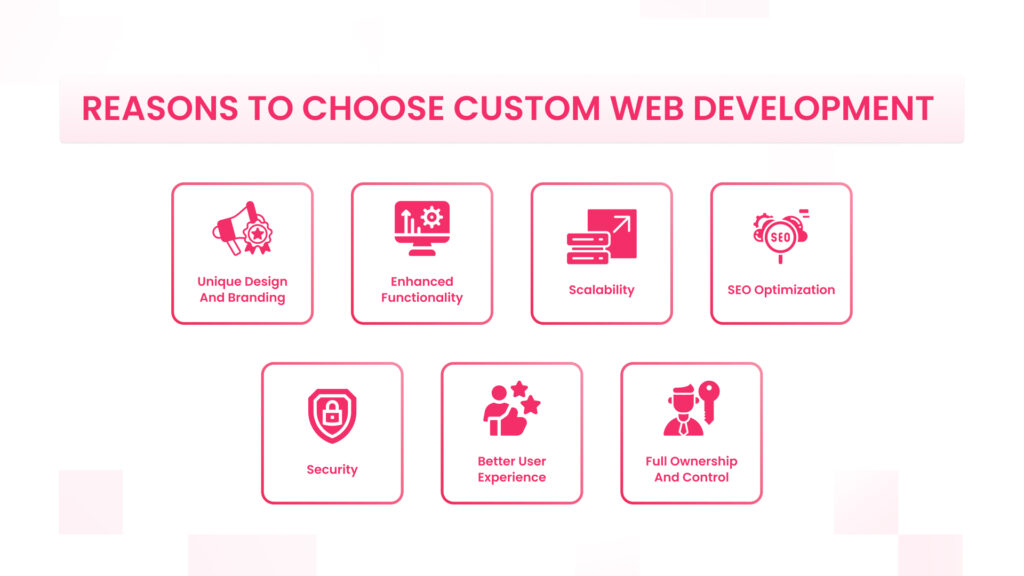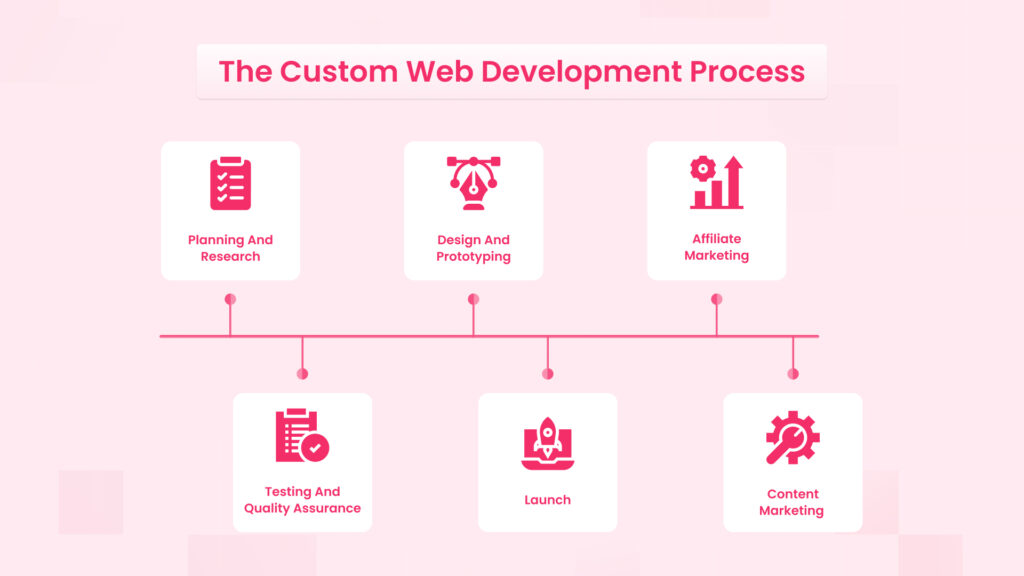A Guide to Custom Web Development: Building Tailored Websites for Your Needs

Online presence is significant, especially in modern times. Having a website is like giving a first handshake to potential customers, clients, or users. It is not every site that is similar to one another: these days, with much software installed to cater for every instance of an individual’s demands, this is not necessary. Many business requirements developed from a unique project make a good example here.
Custom web development, unlike using pre-made templates, includes, as a specific business clarification, a website built from scratch or with heavy-handed modifications of an existing one to meet highly personalized, never-generic “business” requirements. By this way, we can maintain both the design and functionalities, and of course UX. This is the perfect chance for embodying the brand’s identity into the website design, increasing conversion rates, and giving your user an exceptional experience.
Considering a bespoke development of the next site? This comprehensive guide is your go-to resource, leading you through all of the certainly necessary and salubrious aspects of the process, advantages, key components and best practices alongside.
Why Choose Custom Web Development?
Off-the-shelf software solutions like WordPress, Wix and Squarespace are popular for quickly and inexpensively creating websites. However, there are limitations in the areas of customization, flexible integration and scalability with ready products. Here are reasons you can choose custom web development instead:

Unique Design and Branding
With custom software development, you can make your website different from any other. It is a presentation of your brand’s identity-from the arrangement of colors to the choice of logo location, from appealing typography to layout, every aspect of custom website design embodies the very identity of your brand. Often, pre-built templates do not reflect an identity and limits customization options, causing a brand to lose its unique qualities in the process.
Enhanced Functionality
Only Custom-made websites can specifically cater for functionalities that meet the requirements of the user. Personalization renders the web development team capable of composing features in a site that fits the needs of the client, ranging from intricate ecommerce structures to membership systems, booking systems, custom forms, and anything that falls in between. This means that the website would be able to serve its purpose effectively without being boxed into the rigidity imposed by pre-made solutions.
Scalability
As your business grows, your website has to grow with it. With custom websites, you can add features or components that you might need later without compromising the integrity or performance of such a site. Under custom websites, the addition of users, products, services, or features really must not provide for any kind of performance problems.
SEO Optimization
To ensure that websites perform well on search engines such as Google, it is vital to do SEO (Search Engine Optimization). With a custom-made website, you can implement great in-house SEO. It may involve looking at the quick loading of pages, the transformation of metadata and then ensuring the correct use of tags and headings. SEO functionalities are limited in pre-built templates, sometimes they require additional plugins.
Need SEO guidance and support to boost your website rankings?
Our Experts Can Help!
Security
Implementation of new security features is possible when building a custom website, which protects your business and its users well. The security protocols and architectures can be made flexible to assure clients by using your preferred encryption for stored data and while being transmitted. The generalization and templated platform are often the one that is the most vulnerable when it comes to potential hacking and security breaches due to updating and patching deficiencies on a regular period.
Better User Experience
User experience (UX) is the key to a website design that determines how people interact with websites. Customize a website so it gives you intuitive user friendly experience, By the use of which it is then easier for visitors to move around, locate whatever they may need, and take actions they require-provided it be a purchase, filling out a form for any query, or whatever that might be.
Full Ownership and Control
When you develop a website on your own, the website’s code and its data are totally yours. It is neither subject to restrictions nor under the influence of such inconveniences that could arise from third-party services, which have boundaries in referencing pricing, features or even policies. This gives you a lot of freedom, a lot of control, in designing or customizing your site right whenever you want.
The Custom Web Development Process
Custom development for the web generally aims to make the application more robust, and the modification takes a systematic and disciplined approach. That process is composed of the deployment of custom web design within several phases:

Planning and Research
Custom web creation begins with preparation and research. The first stage relates to defining what should be achieved on the website and what the website will achieve. Forget that purpose! Updated sales, capturing leads, services advertising, or high levels of added value content can be generated from the website.
You will also have to describe to your target audience who they are, what their needs are, and how your website can cater to those needs. This information will help you make UI/UX design, functionality, and content decisions.
Key aspects of Planning a website:
- Identifying the purpose of the website: is it for ecommerce, a portfolio, a blog, or something else?
- Analyze the Audience: Define their needs, preferences, and behaviors.
- Competitive Analyses: Enabling the identification of the robust and weak points of competitive websites.
- Specification: These are the attributes that you want in the site, including the phone form, social media support, and it should have a blog.
Design and Prototyping
Once the planning phase ends, the design team moves to the next step, and that is design. This stage is marked by visualization of wireframes, mockups, and prototypes of the website. This represents what the website would appear and function like in reality.
The Design process includes:
- Wireframing: Wireframing is all about the placement of elements and navigation on a website and the summation of what the finished site would look like.
- Mockups: These are precise visual designs of the website that represent its color pallet, typography, branding, and other factors.
- Prototyping: Interactive prototyping is a reference model of a website that can test the user experience and flow of the website before development.
In this step make sure that the site is user-friendly, responsive (mobile-friendly), and visually speaks your brand.
Development
The development phase where the actual coding of software takes place. In the end past stages, the development organization will write HTML, JavaScript, CSS, and every remaining code that advice the site to build the website’s front-end (something whose users view) and the back end (executing a server-side function).
Key aspects of development phase include:
- Front-End Development: This involves the creation of visual elements and interactive features through HTML, CSS, JavaScript, and other technologies on a website.
- Back-end Development: It encompasses the server-side components which may include databases, server settings, and function requirements in order to help the front end.
- CMS: Content managed systems like WordPress, Drupal, or a custom CMS are required for frequent content updates.
Need Reliable Web Development partner to help grow your Business
Our Experts Can Help!
Testing and Quality Assurance
Before the site goes live it should be carefully tried out to make sure that everything works okay. In testing, it should include ensuring:
- Cross-browser compatibility: The website is supposed to look and function appropriately across a wide range of browsers (Google Chrome, Firefox, Safari, and others).
- Mobile responsive design: A website that works well even on smartphones and tablet devices.
- Performance testing: Testing the load time and optimizing websites for faster performance.
- Security testing: Inspecting website security to ensure that potential threats or vulnerabilities are effectively secured.
For this purpose, the present phase includes debugging applications and processes.
Launch
After the completion and testing of the website, this site is now hosted, and promotion begins with the target audience. Some activities can be incorporated during this stage itself such as:
- Domain Name Registration: Registration of the special domain name necessary for your website.
- Web Hosting Setup: Setting hosting up to ensure that your websites are actually available on the internet.
- Deployment: Making the website public.
Ongoing Maintenance and Update
Websites change continuously and can’t function effectively, especially those which require regular updating and security updates. On the matter of updating a website–this happens when one has got a website replete with security updates, designs, and content refreshing. In this phase one will do the following:
- Performance Monitoring: Supervising the performance of the website and making necessary enhancements.
- Content Changes: Updating or adding new content regularly, which should keep the Web site fresh and appealing to visitors.
- Security Updates: The update of the most up-to-date security protocols and patches to secure the site.
Conclusion
Websites are developed specifically for the individual needs of your business or personal use through custom website development. This makes it possible to create an authentic signature website, which satisfies the functional requirements and offers seamless user experience.
Therefore, the creation of a unique website prototype begins with careful planning, designs, setting up codes, testing, and post-deployment to ensure a business is the best website on the planet. Best practices can lead to improvements toward exactly what makes your website look well-designed and possibly effective for website design.
Regardless of the type of website you are working on, whether you wish to build an online store, a business website, or personal portfolio, custom web development provides unmatched flexibility, scalability, and control aspects. In this way, the future-proof nature of your website is assured, containing today’s and tomorrow’s requirements.
 Shopify
Shopify










